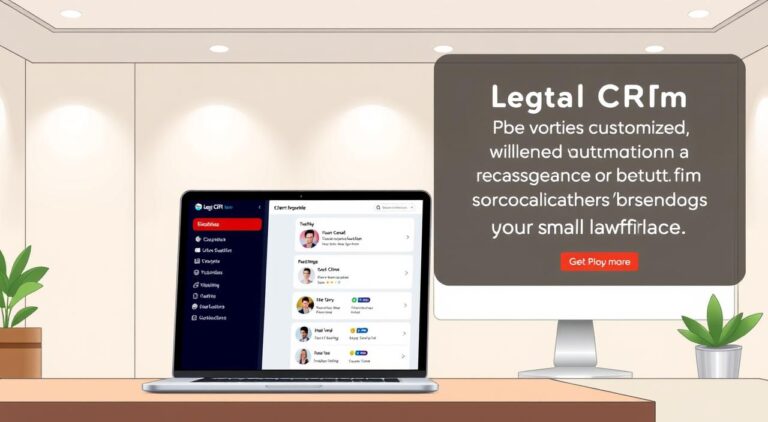Document Automation Tools for Small Law Firms US: Benefits
Quick answer: Modern legal document automation lets U.S. practices cut routine drafting time and reduce errors so attorneys can focus on strategy and client work.
Legal teams now use AI-enabled software and proven platforms like Clio, DocuSign, HotDocs, Briefpoint, and NetDocuments to speed intake, generation, and review.
Why it matters: No-code builders and advanced logic make it practical for lean operations to deploy consistent templates, preserve compliance, and improve client responsiveness.
What to expect: Faster turnaround, fewer revisions, clearer audit trails, and measurable gains in billable time and referrals.
Key Takeaways
- Automation shortens drafting cycles and cuts human error.
- AI-assisted solutions suit teams with limited IT staff.
- Start with high-volume templates and add conditional logic.
- Choose vendors that offer encryption, access controls, and audits.
- Affordable plans exist; evaluate cost vs. recovered time.
Quick Take: What small firms gain from legal document automation today
Firms that deploy smart template workflows see faster turnarounds and fewer revisions across common matters.
Snapshot — immediate, measurable wins:
- Time recovered: Generate engagements, NDAs, pleadings, and letters in minutes, not hours — recapturing billable time.
- Fewer errors: Standard templates and conditional logic keep language consistent and compliant.
- Better client experience: Faster turnaround and mobile e-sign flows reduce back-and-forth delays.
- Simpler operations: Integrations with case management and DMS centralize files and communications.
- Proven results: Users report 60–90% faster cycles; Briefpoint cuts discovery drafting by ~87% and HotDocs users report up to 90% faster processing.
- Trusted platforms: DocuSign adds mobile-friendly signatures and audit trails while Clio ties documents to billing and case records.
- Scalable, predictable pricing: SaaS plans let teams add users and templates without rebuilding workflows.
What legal document automation is and why it matters for small law firms
Legal document automation replaces repetitive drafting with dynamic templates and question-based workflows. This shortens cycles and reduces errors so attorneys can focus on strategy.
From templates and conditional logic to auto-filled client data
Definition: A system where lawyers use dynamic templates and conditional logic to assemble documents quickly and accurately.
Inputs: Intake forms capture client data once and the platform auto-fills names, dates, clauses, and figures.
Core benefits: speed, accuracy, consistency, and client experience
- Faster document creation with guided prompts and branching logic.
- Fewer typos and omissions thanks to standardized templates and checks.
- Works across agreements, pleadings, discovery, and estate plans.
- Cloud-based workflows enable secure, remote collaboration and reuse of client details.
“A single intake can populate multiple outputs, moving matters from intake to signature with fewer steps.”
Result: A reliable, repeatable path from intake to e-signature that saves time and enforces firm standards for law firms.
Best document automation tools for small law firms US in 2025
Here’s a concise lineup of solutions that cut drafting time and tighten review and signing workflows.
Quick roundup: Below are top platforms, standout features, and ideal use cases. Choose those that match your dominant matters to shorten time-to-signature.
-
Briefpoint & Bridge:
- Purpose-built for discovery: upload RFPs, select objections, download Word.
- Client response collection auto-inserts answers; avg. 87% time saved.
-
Clio + Lawyaw (Clio Draft):
- Combine billing, CRM, and case management with template assembly.
- Good when you want matter-centric records and billing linked to docs.
-
Gavel & HotDocs:
- Gavel: no-code editor, intake questionnaires, collaborative editing; tiered pricing.
- HotDocs: advanced branching, offline work, ideal for complex templates at scale.
-
DocuSign, PandaDoc, Formstack:
- DocuSign: leader in e-signatures, audit trails, bulk send.
- PandaDoc: create, negotiate, sign with CRM and payment links.
- Formstack: intake + eSign with HIPAA/GDPR options.
-
NetDocuments, Spellbook, Contract Express, Smokeball:
- NetDocuments: routing, version control, Word integration.
- Spellbook: AI review that flags missing clauses and contract risks.
- Contract Express: enterprise clause libraries; Smokeball: simple all-in-one practice stack.
Selection tip: Test mixes that match your matter mix and desired features. Try vendor demos to confirm integrations and user experience before purchase.
How to choose the right document automation software for your law firm
Begin with the five templates that cost you the most time and find a platform that excels with those patterns.
Match features to matter types first. List the top contracts, discovery sets, pleadings, and NDAs you create. Then shortlist vendors that handle those formats well—HotDocs for complex branching, Briefpoint for discovery, and Gavel for no-code questionnaires.
User experience matters. Favor no-code builders so attorneys and staff can build templates without IT. A clean interface speeds onboarding and reduces errors.

Integration and data flow
Verify integrations with your case management and document management system to avoid duplicated entries and silos. Ensure client information flows from intake into multiple documents automatically.
Pricing, scalability, and support
Compare pricing tiers and hidden costs like storage, eSign envelopes, and API access. Confirm scalability—what works at $15/month may not scale to high-volume matters.
“Test a live pilot with real templates to validate speed, accuracy, and staff adoption.”
- Start with your top five document types and volume patterns.
- Prioritize no-code editors and quick onboarding.
- Confirm case management and DMS integrations before purchase.
- Check pricing tiers, storage, and e-sign costs for scale.
- Evaluate vendor onboarding, training, and SLA responsiveness.
Final step: Run a short pilot that measures time saved and error reduction. Choose the right document automation by proving it on the work that matters most.
Building a lean legal tech stack: document automation, DMS, and eSign
A compact tech stack ties intake, drafting, storage, and signing into a single, trackable workflow.
Document management system vs. generation engines: what each solves
Role clarity: A document management system like NetDocuments handles version control, permissions, routing, and retention. Generation engines such as Gavel and HotDocs assemble content with branching logic and smart fields.
Connecting intake forms to multi-document generation
Use intake forms (e.g., Formstack) to capture client data once and feed that data into templates that produce multiple documents. This reduces rekeying and keeps language consistent across outputs.
- Standardize naming and folder structure in your DMS to speed retrieval.
- Map form fields to template variables so one capture drives many files.
- Push finalized files back to the matter workspace to maintain a single source of truth.
E-signature workflows that reduce delays and human error
Integrate a signature provider like DocuSign to add signing order, reminders, and audit trails. Configure reminders and signing order to cut follow-up time and close matters faster.
“Measure cycle time from intake to signature to quantify gains from the integrated stack.”
- Add audit trails for who viewed, edited, and signed each artifact.
- Use routing and approvals to move drafts through review without email chaos.
- Ensure encryption in transit and at rest across all components.
- Aim for the fewest systems that fully cover intake to e-sign to simplify management.
Security, compliance, and data governance in legal document workflows
Build trust by making governance a visible part of every workflow. Start with access rules and encryption, then layer audit trails and versioning so the team can prove who did what and when.
- Enforce least-privilege access with role-based permissions and MFA across each management system and app.
- Require encryption in transit (TLS 1.2+) and at rest; review vendor SOC reports and security attestations.
- Keep immutable audit trails for edits, views, and signatures to preserve defensibility and client trust.
Operational safeguards that reduce risk:
- Use version control so legal teams always work from the authoritative draft and retain history.
- Validate vendor adherence to legal standards and privacy frameworks (GDPR, HIPAA, PCI) and confirm data residency and retention options.
- Implement DLP policies for sensitive client information and train staff on secure sharing and redaction.
Governance and testing: Centralize policy and template management to keep language consistent. Automate approval workflows to avoid ad hoc sign-offs that create exposure. Periodically test incident response and run access reviews to keep controls current.
“Audit trails, encryption, and tight access controls turn a workflow into a defensible practice.”
Implementing document automation without disrupting your practice
Begin with the forms and templates that eat the most staff time each week. Triage the top three to five templates by volume and error rate to capture quick wins and clear ROI.
Start small: prioritize high-volume templates and quick wins
Pilot one matter type with a small team. Use Briefpoint, Gavel, or HotDocs to add conditional logic and smart fields that cut repetitive edits.
Standardize templates with conditional logic and smart fields
Standardized templates reduce rework and speed drafting. Map common client fields once so the system fills names, dates, and clauses across outputs.
Training, change management, and vendor support
Schedule vendor-led training and create one-page quick guides. Link your templates to management software like NetDocuments and set e-sign sequences with DocuSign.
- Measure cycle time, rework rate, and eSign turnaround weekly.
- Pilot, gather feedback, iterate, then expand firm-wide.
- Phase in bulk generation and complex branching after basics are stable.
- Create a governance checklist to approve new template requests and stop sprawl.
“Start narrow, prove impact, then scale—this keeps disruption low and adoption high.”
Proving ROI: metrics that matter for small law firms
Measure impact with a tight dashboard that links time, quality, and cash flow. Start with a baseline week and capture average minutes from draft to signature. That single metric makes gains visible to partners.

Time saved per document and reduction in rework
- Track average time per document: measure draft-to-signature before and after changes. Target 60–90% faster processing, as reported by HotDocs and Briefpoint users.
- Measure rework: record percentage of files needing edits. Lower error rates show quality gains in document creation.
Lower operational costs and improved profitability
- Calculate labor savings by multiplying minutes saved by blended billing rates.
- Attribute wins to specific features like conditional logic, routing, and eSign reminders to justify software spend.
Faster turnaround, higher client satisfaction, and capacity gains
Faster turnaround improves client response SLAs and speeds cash collection through quicker engagement execution.
Capacity gains let firms handle more matters per attorney without adding headcount. Present ROI within 6–12 months and reinvest time into business development.
“Use weekly dashboards to visualize KPIs and guide continuous improvement.”
Document automation tools for small law firms US: positioning your firm for growth
Position your practice to grow by treating smart template workflows as a revenue lever. Standardized outputs speed delivery, cut errors, and create capacity to take on higher‑value matters.
Choose platforms that scale with you—from solo to small teams—by prioritizing integrations with Microsoft 365, Google Workspace, and your case management system.
- Standardize and sell higher-value work: Master complex legal document templates and contract workflows to win larger engagements.
- Align technology with practice strategy: Select the best document automation and automation software that match your dominant matters.
- Make onboarding frictionless: Build repeatable playbooks so new hires follow the same steps from day one.
- Use data to refine focus: Track throughput and costs to spot profitable matter types and bottlenecks to fix.
- Scale without losing quality: Enforce governance and maintain a library of approved templates to preserve consistency.
Differentiate your law firm by promising—and delivering—faster, error‑resistant outputs. Stay agile: add modules and integrations only when they remove friction, and plan for AI enhancements (like Spellbook) that augment review while keeping final judgment with attorneys.
Conclusion
Conclusion
Adopt smart workflows to turn repetitive drafting into a competitive edge.
Start with a short pilot on your highest-volume template, track time-to-signature, and measure error reductions. Use a connected stack—document automation software, a DMS like NetDocuments, and DocuSign—to keep client data flowing from intake to final legal document.
Choose proven names such as Clio, HotDocs, Briefpoint, Gavel, Formstack, Spellbook, and PandaDoc when they match your matter mix. Prioritize security, version control, and governance to meet legal standards and protect clients.
Next step: run a one-matter pilot, quantify time saved, then scale templates that deliver the best legal and business results.






